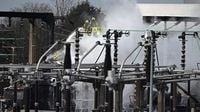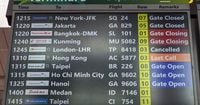On Friday, March 21, 2025, a massive fire shut down operations at London's Heathrow Airport, one of the world's busiest airports, leading to unprecedented disruption for travelers. The blaze, which originated at an electrical substation, disrupted over 1,300 flights and impacted an estimated 145,000 passengers. Travelers were advised to avoid the airport throughout the day and expect significant delays in the coming days.
According to Heathrow Airport's official statement on social media, the closure was necessary due to the power outage caused by the fire. “Due to a fire at an electrical substation supplying the airport, Heathrow is experiencing a significant power outage. To maintain the safety of our passengers and colleagues, Heathrow will be closed until 23h59 on 21 March. Passengers are advised not to travel to the airport and should contact their airline for further information. We apologize for the inconvenience,” the announcement said.
The incident has prompted serious concerns about the resilience of infrastructure supporting major institutions like Heathrow. British Energy Secretary Ed Miliband described the event as “catastrophic” and characterized the situation as unprecedented, citing the importance of learning lessons regarding protective measures for such critical facilities.
As the fire raged on, the London Fire Brigade deployed approximately 70 firefighters, who worked tirelessly to control the blaze. LFB Assistant Commissioner Pat Goulbourne reported that firefighters had successfully contained the flames by just after 8 a.m. local time. “This was a very visible and significant incident, and our firefighters worked tirelessly in challenging conditions to bring the fire under control as swiftly as possible,” he shared, emphasizing the importance of a coordinated multi-agency response.
Concerning the cause of the fire, local officials stated that it remains under investigation but indicated there was “no suggestion” of foul play. Residents in areas around the airport experienced interruptions, with over 16,300 homes facing power outages due to the incident. Reports indicated that about 150 people were evacuated as a precaution.
This calamity occurred at a time when Heathrow was seeing record passenger numbers. Earlier in January 2025, the airport recorded its busiest month with over 6.3 million passengers. The report indicated a notable increase in passenger traffic, especially in transatlantic travel, with averages exceeding 200,000 passengers daily for 11 consecutive months.
Flight disruptions extended beyond the airport, with major airlines like Cathay Pacific rerouting flights and canceling scheduled services. On Friday alone, at least 1,350 flights were canceled or had to be redirected to other airports including Gatwick, Charles de Gaulle in Paris, and Ireland's Shannon Airport. Even flights already in the air, such as those from JFK Airport in New York, had to be diverted.
The chaotic scenes outside Heathrow stood in stark contrast to the eerie quiet within the usually bustling terminals. Desolate drop-off zones and empty airline counters illustrated the impact of the closure, leaving many travelers stranded. Reports indicated that travelers were frustrated, with some scrambling either to book alternative flights or waylaid at hotels, unable to afford accommodations due to the sudden disruption.
Amidst the anxiety and frustration, passengers like James Porritt said, “We are stuck,” expressing concerns over his travels to Australia. Others shared similar sentiments, noting personal situations like weddings or funerals that were disrupted due to the unforeseen closure.
Social media became a platform for many to voice their complaints and seek assistance. Many flights arriving from various destinations were either rerouted or canceled, leading to confusion and disappointment among travelers worldwide. The impact was felt not just locally but across global aviation routes, affecting airlines and passengers alike.
As the night closed in on March 21, Heathrow Airport executives continued to work on addressing the disruption while seeking to resolve power issues. The extensive outage and ensuing fire underlined the critical vulnerabilities within crucial infrastructure. Observers are urging immediate reflections on lessons learned to ensure future disasters are effectively mitigated and service disruptions seldom occur.
The closure of Heathrow, scheduled to last until at least 11:59 p.m. on the day of the incident, is expected to have a cascading effect that may result in continuation of disruptions days beyond today. With as many as 290,000 passengers possibly affected, the ramifications of this incident will be felt across multiple sectors evident in the travel and transport landscape.
Heathrow normally operates flights starting at 6 a.m. due to prior restrictions, and the anticipation ahead signals that reopening may bring its own challenges with such a substantial backlog of travelers and logistics to manage. In the wake of the incident, stakeholders within the transport and energy sectors will likely review the adequacy of emergency responses, signaling important discussions on infrastructure resilience in the United Kingdom.





